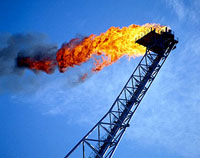Saudi Arabia’s intention to boost oil output may cut world prices down
Saudi Arabia, the largest producer of oil in the world, announced its intention to boost the output by 200,000 barrels a day (or by two percent) from June to July. The oil-rich nation already increased the output in May, but the oil market ignored the initiative due to strong demand on oil in the world.

Prices on oil were held steady on Monday, June 16, as traders think over the implications of Saudi Arabia’s plans.
Light, sweet crude for July delivery was up 8 cents at US$134.94 a barrel in electronic trading on the New York Mercantile Exchange by noon in Europe . It fell US$1.88 to settle at US$134.86 on Friday.
However, traders said concerns that sustained high prices will suppress global appetite for oil may push the Organization of Petroleum Exporting Countries, or OPEC, into action to stabilize the market.
"This is not a one-way story now. The industry is becoming more jittery and beginning to respond. Saudi, and OPEC generally, fear permanent demand erosion at these price levels," said Mark Pervan, senior commodity strategist at Australia and New Zealand Bank in Melbourne, Australia.
Traders will be watching for outcome of a June 22 meeting of oil producing and consuming nations in Jeddah, called by Saudi Arabia to seek ways to tackle soaring energy prices.
"As we look ahead to this week, all eyes will be on Sundays 'oil price summit' in Jeddah," said analyst and trader Stephen Schork, in his Schork Report. "If the Saudis do not succeed in popping the balloon here, then off to US$150 we go."
Crude prices have reached record highs, surpassing US$139 per barrel on June 6 after surging nearly US$11 in the biggest single-day price leap ever. The price of a barrel has swung back and forth in a band about US$10 wide since then.
In its monthly market report, the OPEC said oil's recent volatility reconfirmed the view that "current price levels do not reflect supply and demand realities."
The cartel cut its 2008 global demand forecast, saying it now expects demand to increase by 1.28 percent to an average of 86.9 million barrels daily, down from a previous forecast of 1.35 percent.
That downward revision follows similar moves by the U.S. Energy Department and the International Energy Agency earlier in the week.
Phil Flynn, an analyst at Alaron Trading Corp. in Chicago, said the revised forecasts suggest global demand for oil is slowing. That trend could accelerate, he added, if prices don't come down soon.
"It's a sign that maybe the bull run could come to an end. You don't want to say that for sure, but you're starting to see some shifts," Flynn said.
In other Nymex trading, July heating oil futures added 3.5 cents to $3.8719 a gallon, and July natural gas futures rose by more than 2 pennies to $12.647 per 1,000 cubic feet. Gasoline futures were up marginally at $3.4695.
In London, July Brent crude lost 66 cents to $134.45 on the ICE Futures exchange.
Subscribe to Pravda.Ru Telegram channel, Facebook, RSS!


